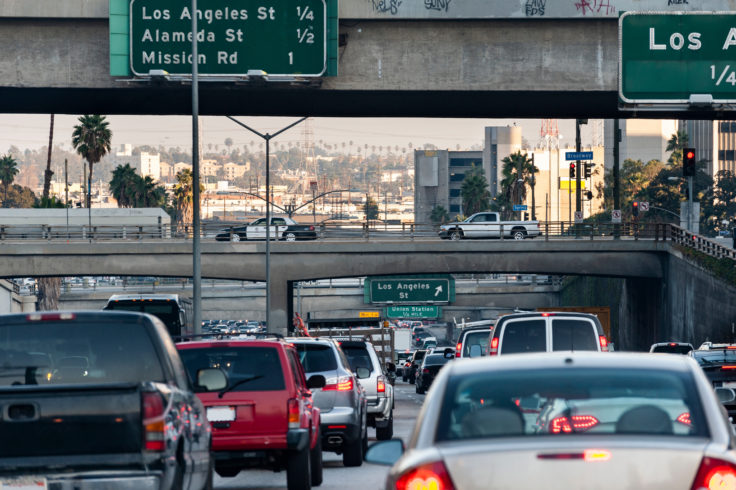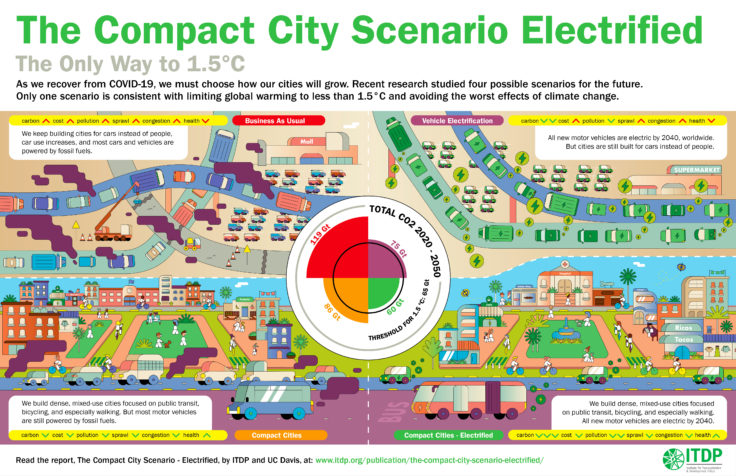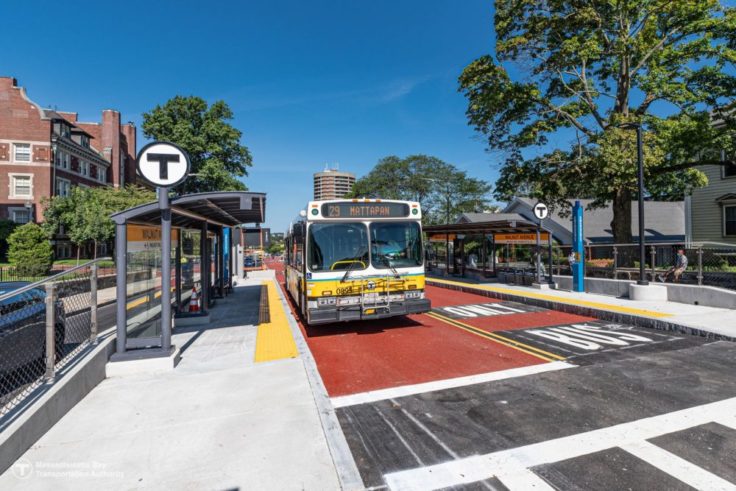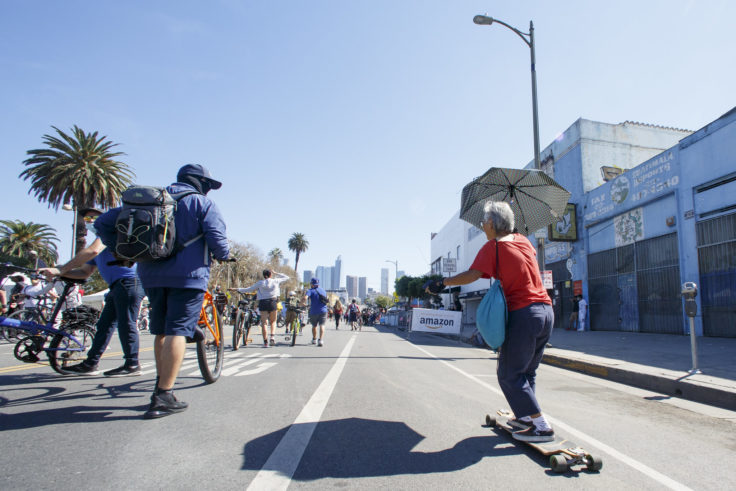July 27, 2022
The Current Fuel Crisis is an Opportunity to Reshape US Cities
While the 1970s were a turning point for the environmental movement in the United States — with milestones ranging from the first Earth Day to the passage of the Clean Air and Water Acts — it was also an era most closely associated with a consequential energy crisis.
For the US to break out of this cycle of fossil fuel dependency, we must rethink how we design, manage, and plan our cities.
The first oil shock of 1973 was brought on by social and political forces that exposed the vulnerabilities of a global system overly reliant on fossil fuels and resource-intensive petroleum production. Everyday Americans witnessed the impacts firsthand, faced with skyrocketing gas prices and ripple effects across the economy for years to follow. Parallels can certainly be drawn from these challenges of half a century ago to the fuel crisis impacting the world in 2022, similarly influenced by a fraught social and political landscape. Now, as the dangers of climate change loom larger than ever, it is imperative that we not repeat the same mistakes by continuing to expand emissions-heavy, fossil fuel-intensive policies and infrastructure as a short-sighted solution.
We need to recognize this crisis as a wake-up call that we must pivot to alternative systems that prioritize sustainable development and de-incentivize fuel-intensive transport in the long-term. Otherwise, we run the risk of perpetuating a cycle of volatility brought on by the country’s over-reliance on fossil fuels, ultimately jeopardizing our environment and our health. For us to break out of this cycle, we must rethink how we design, manage, and plan infrastructure in American cities.
Urban areas specifically are responsible for nearly 80% of total carbon emissions growth from vehicles alone over the last few decades, as urban sprawl has led to more roads, highways, and car usage. Overall, transportation accounts for over 34% of the nation’s carbon pollution, the highest-polluting sector in the economy. While cities bear the biggest burden for fuel consumption, they also hold the key to piloting and implementing solutions that can set us on a different course for the future.

Prioritizing Compact Development & Electrification
If we are to learn anything from the energy crises of the past, it is that change is possible if we start with our cities — a model exemplified by the forward-thinking actions of places like Amsterdam and Copenhagen, both of which made stark pivots towards improving public transit and cycling infrastructure after the 1970s. These efforts solidified their global reputations as green, livable cities while also making their local economies less susceptible to future oil shocks.
To respond to our current crisis, US cities need to do the same by prioritizing more electric-first, compact development strategies that offer long-term alternatives to fuel-dependent infrastructure. In ITDP and UC Davis’ The Compact City Scenario – Electrified, a strong case is made for taking dual policy approaches that emphasize both compact urban development and vehicle electrification — while ultimately transitioning away from cars — in order to successfully reduce emissions and the burden of fossil fuels. These approaches have the potential to lower cumulative emissions from urban passenger transport by an estimated 59 gigatonnes by 2050.
Ensuring denser urban growth requires strategies that directly address and improve land use, walking and cycling networks, and accessible public transit — all while disincentivizing individual car usage. As estimated in ITDP’s report, compact mixed-use cities that promote public transit, cycling, and car traffic management measures could save the world an estimated $5 trillion in direct public and private costs every year by 2050, significant capital that could be invested into many other essential public services.
We need to ensure that we continue supporting and scaling measures that make density and electrification priorities in city and transport planning. We need only to look towards policies and projects underway in cities like Boston, Los Angeles, and Minneapolis to see glimpses of a future that is possible — if and only if governments and leaders make staunch commitments to reshaping urban infrastructure.

Investing in Electrification in Boston
In Boston, where ITDP has been leading the BostonBRT effort to bring a bus rapid transit network to the region, the Massachusetts Bay Transportation Authority (MBTA) has a Better Bus Project plan that aims to optimize bus routes and increase service by 25% overall across the metropolitan area. A key component of the plan, which itself is part of a larger $8 billion, 5-year transit improvement strategy, is the commitment to bus fleet electrification and service enhancements that include transitioning to zero-emission, battery electric buses (BEBs) along with supporting infrastructure.
This plan also includes a targeted $100 million annual investment in expanding fleets of BEBs across the MBTA service area, while working to center equity and access for riders. Fare-free pilot programs along major bus routes in Boston, for example, seek to increase ridership and expand access for diverse types of populations. In addition, the implementation of New England’s first center-running bus lane in 2021 along a key route has increased reliability and ridership.
Stemming from the pandemic, funding for 14 miles of bus priority lanes across the region have also helped increase dependability and efficiency, with the focus now turning to expanding High Frequency Corridors. While certainly a time and capital-intensive effort, Boston’s emphasis on electrification and bus priority has the potential to not only diminish a costly reliance on fuel, but also eliminate nearly 74,876 tons of annual tailpipe emissions from its current bus fleet.

Rethinking Car Culture in Los Angeles
While Los Angeles is a city most often associated with ‘car culture’, it also holds great potential for transformation if city and neighborhood-level actions are taken to make walking, cycling, and transit-oriented planning a priority. More compact and denser development scenarios are possible in LA, as demonstrated in the city’s 2019 Countywide Sustainability Plan.
With cross-city collaboration and community organizing, steady changes are already taking place — recent approval of the NoHo-Pasadena Transit Corridor, for example, will create a BRT system that reduces car usage, serves communities in four cities, and introduces more zero-emission electric vehicles. In a city where air pollution and gas consumption are so tangible, it is essential that LA’s current and future leaders advance on a commitment made by the Mayor’s Office to establish a zero-emission area (ZEA) by 2030. As ITDP’s ZEA Planning Guide for Los Angeles lays out, multiple equity and planning considerations are needed to make a ZEA a success so that it not only reduces emissions, but also creates a more inclusive and healthier city.
A ZEA in LA would prioritize electric buses and transit and incentivize a faster shift to electric freight, supporting California’s statewide policy to achieve full vehicle electrification by 2035. A key element of this effort includes redesigning streets and roads to make them safer and friendlier for pedestrians and cyclists, while ensuring that car-centric highway expansions are stopped. As acknowledged in the Planning Guide, careful considerations are needed to ensure that ZEA-related street transformations do not perpetuate displacement and gentrification, especially in vulnerable and high-need areas.
Dedicated community and local advocacy in LA has been shown to be effective in reclaiming land from new highway construction, potentially in favor of more connected, community-driven development. For change to take place in a city like LA, top-down and bottom-up approaches that reflect community needs and garner public support for citywide transformation are essential to shifting behaviors and de-incentivizing car use.

Less Parking, More Transit and Cycling in Minneapolis
Urban parking has long served a concept of ‘if you build it, cars will come’. Many parking policies across US cities still revolve around an outdated, car-driven framework that prioritize sprawling parking complexes in residential and commercial development. These policies often fail to reflect actual demand or meaningful land use strategies that could instead promote more public space, housing, and transit access. In recognition of the need to reform parking strategies, many cities are now taking approaches to rethink how they build and manage their urban space.
For example, after years of gradual progress, the city of Minneapolis adopted a Minneapolis 2040 plan that includes the complete elimination of parking minimum requirements and the strengthening of maximums for new construction projects across the city. Reducing parking availability would not only reallocate space from car storage to better uses, like affordable housing, but also encourage fewer unnecessary trips by car and more transit ridership.
In 2021, the city also passed a parking reform ordinance that included requirements for strengthening bicycle infrastructure and accessibility to reclaim streets from cars and offer more transport alternatives. By promoting denser residential development, less parking, and more walking and cycling, the city is moving towards more sustainable forms of mobility that prioritize people and safety, rather than fossil fuels and cars.

There is certainly no encompassing, easy solution to mitigating the US dependence on fossil fuels, but it is clear from our current crisis that we cannot continue a business-as-usual approach. We need to re-envision our infrastructure and transport systems, or end up emerging from this crisis even more committed to an unsustainable and harmful future. By looking at examples of how nations underwent swift energy transitions in response to the 1970s, we can see that transformation is possible — but only if we build the social and political will to advocate for, and invest in, the right solutions.
With the passage of the Infrastructure Investment and Jobs Act (IIJA) in 2021, which includes a historic $284 billion in new funding for transportation, we now have an important opportunity for change in the US. Urban areas have perhaps the most critical role to play as major consumers of fossil fuels and emitters of carbon emissions from transport and related sectors. City officials and decision makers must make more collective efforts to prioritize compact, electric-driven development scenarios anchored by public transit, cycling, and pedestrian infrastructure.
From models like Boston, LA, and Minneapolis, we can see that steady progress is being made, but cities need to remain steadfast in their commitments in order to have a scalable impact. For US cities and states to make a significant transition for the long-term — and before the next crisis strikes — we need a national shift in policies, behaviors, and resource allocation. Otherwise, if we cannot learn from our history, we are only doomed to repeat it.
